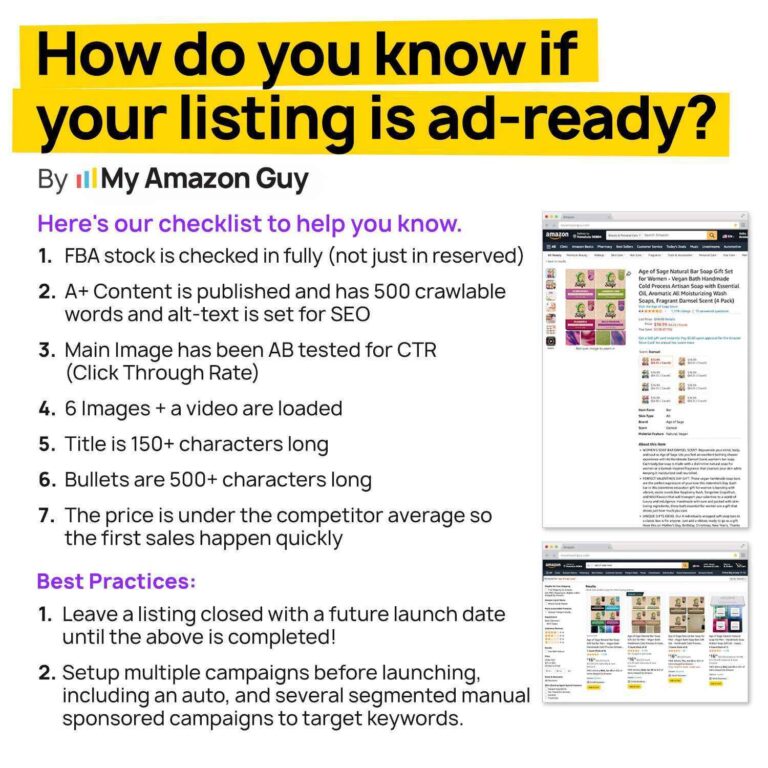Ready to waste money? If not, let’s talk about the Amazon PPC pre-launch mistakes that most sellers make—without even knowing it.
You’re ready to dive into Amazon PPC, but hold on—before you hit “launch,” you could be making critical pre-launch mistakes without even realizing it. These errors often happen in the planning phase and can lead to wasted budget, poor click-through rates, and missed sales.
The worst part? Goal setting, budgeting, keyword research, and listing optimization are often overlooked, making your campaign far less effective than it could be.
But here’s the good news: knowing these mistakes and how to avoid them can set you up for success. To help, our Amazon agency offers a PPC guide that serves as a blueprint for launching campaigns the right way and avoiding costly missteps.
Table of Contents
1. Amazon PPC Pre Launch Mistakes: No Clear Goal = No Clear Results
If your PPC strategy is just “I want more sales,” you’re already in trouble. Are you aiming for brand awareness? Ranking a new product? Profitability? Break-even for keyword ranking?
Mistake: Running ads without defining clear goals.
Fix: Set specific targets—like a 20% ACoS (Advertising Cost of Sales) for profitability or a 100% ACoS to aggressively rank a new product.
SMART Goal Setting
SMART goals are crucial for Amazon PPC success. They provide direction, track progress, and guide decisions. Here’s how to set them:
Specific – Define exactly what you want to achieve (e.g., “Increase product X sales by 20%”). Who’s involved? Where? Which resources? Why is this important?
Measurable – How will you track progress (sales, ACoS, CTR)? Quantify your goal (e.g., “Increase CTR by 10%”). What data?
Attainable – Is the goal realistic? How will you achieve it (keywords, bids, ad copy)? Do you have the skills?
Relevant – Does the goal align with your Amazon seller objectives? Is it worth it (ROI)? Is this the right time?
Time-Bound –Set a deadline (e.g., “Increase sales by 20% in the next quarter”). What are the milestones?
Example: “Increase ‘Wireless Headphones X’ sales by 15% within two months of launch, targeting relevant keywords with a $500/month budget and under 35% ACoS. Track weekly via sales, ACoS, and conversion rate. This establishes market share and generates early revenue.”
2. Amazon PPC Campaign Pre Launch Mistakes: Setting a Budget Without Data
Amazon PPC isn’t a “set it and forget it” game. If your budget is too low, your ads will barely run. If it’s too high with no strategy, you’ll burn cash fast.
Mistake: Choosing a random budget without analyzing competitors or CPC (Cost Per Click).
Fix: Use keyword research tools to estimate CPC, then plan your daily budget accordingly. Start low and adjust based on performance.
PPC Budget Allocation
Set Your Budget & Goals
Determine your total ad budget and allocate it based on sales targets. Work backward using click-through rates, conversion rates, and CPC to estimate costs.
Prioritize Sponsored Products
Most sales come from Sponsored Product campaigns. Allocate 80% of your budget to manual targeting (keywords) and 20% to auto campaigns for discovery.
Segment Campaigns & Track Performance
Separate ASINs into different campaigns to track spend and profitability. Identify high-performing ASINs and shift budget accordingly.
- Avoid Highly Competitive Niches with Low Budgets
If CPC is too high, a $50/day budget won’t be effective. Instead, focus on long-tail, hyper-relevant keywords for better ROI.
Adjust Strategy Based on Stock Levels
Running out of stock? Reduce PPC spend rather than pausing completely to maintain ranking. Use exact match keywords and auto campaigns strategically.
Monitor & Optimize Regularly
Watch Amazon’s budget limits, optimize bids, and adjust spend based on performance trends.
3. Amazon PPC Pre Launch Mistakes: Guessing Keywords
If you think throwing in random high-search keywords will do the trick, think again.
Mistake: Targeting broad, high-competition keywords without considering relevance and conversion rates.
Fix: Use tools like Helium 10 or Jungle Scout to find high-converting, long-tail keywords. Always check search volume, competition, and relevance before adding keywords.
Single vs. Multiple Keyword Campaigns for Amazon PPC
When to Use Single Keyword Campaigns:
✅ Best for high-volume, competitive keywords.
✅ Allows precise control over campaign placement (e.g., top-of-search dominance).
✅ Useful for ranking strategies and isolated budget allocation.
When to Use Multiple Keyword Campaigns:
✅ Ideal for 98% of campaigns—more balanced and scalable.
✅ Enables broader reach while maintaining cost efficiency.
✅ Leverages Amazon’s campaign placement optimization.
Single keyword campaigns work well in niche cases, but a multiple keyword approach is generally more effective for budget control and overall PPC performance.
4. Amazon PPC Pre Launch Mistakes: Ignoring Negative Keywords
Negative keywords tell Amazon when NOT to show your ad. If you skip this step, you’re paying for clicks that will never convert.
Mistake: Forgetting to add irrelevant search terms as negative keywords.
Fix: Add irrelevant terms like “used,” “cheap,” or unrelated variations to avoid wasted spend.
Why Negate Keywords in Amazon PPC?
Negating keywords cuts wasted ad spend and boosts efficiency. If a keyword has high spend but no sales, negate it. Use exact match to block specific phrases or phrase match to exclude all variations.
Regularly check search term reports to remove high ACoS or irrelevant terms. Optimizing negatives ensures your budget drives profitable sales!
5. Amazon PPC Pre Launch Mistakes: Running Ads With a Garbage Product Listing
If your product page looks like it was thrown together in five minutes, don’t expect your ads to convert.
Mistake: Launching PPC before optimizing the title, bullet points, description, images, and A+ content.
Fix: Your listing should be keyword-optimized, benefit-driven, and visually appealing before running any ads. To create ad-ready listings, read our blog post “Amazon Retail Readiness: 11 Steps To Make Ad-Ready Listings.”
6. Amazon PPC Pre Launch Mistakes: Auto vs. Manual Campaign Confusion
Both auto and manual campaigns have their place, but if you rely only on one, you’re missing out.
Mistake: Running only auto campaigns (too broad) or only manual campaigns (too restrictive).
Fix: Start with an auto campaign to gather data, then create manual campaigns using high-performing keywords.
When to Use Manual vs. Auto Campaigns
- Manual Campaigns
Ideal when you want precise control over keywords, bids, and targeting. Best for optimizing high-performing keywords, testing new strategies, and maximizing ROI with detailed adjustments.
- Auto Campaigns
Great for discovering new keywords, gathering data, and doing a product launch without deep research. Best for broad audience reach and leveraging Amazon/Google’s algorithm to find opportunities.
For a balanced strategy, use auto campaigns to identify trends and manual campaigns to refine and optimize performance.
7. Amazon Ad Campaign Pre Launch Mistakes: Forgetting to Segment Match Types
Amazon offers Broad, Phrase, and Exact match types—each serves a different purpose.
Mistake: Throwing all keywords into one ad group without separating match types.
Fix: Use Broad for discovery, Phrase for targeting, and Exact for precise control. Keep them in separate campaigns to track performance properly.
When to Use:
- Exact Match – Best for conversions and precise targeting.
- Phrase Match – Expands reach while staying relevant to the keyword.
- Broad Match – Use for discovering new keywords and expanding reach, especially in the early stages of a campaign.
8. Amazon PPC Pre Launch Mistakes: Bidding Too Aggressively (or Not Enough)
Too aggressive? You’ll burn through your budget in hours. Too conservative? Your ads won’t even show up.
Mistake: Setting bids without understanding CPC trends and competition.
Fix: Start with suggested bids, then adjust based on performance. If your CTR (Click-Through Rate) is high but conversions are low, tweak your listing instead of blindly increasing bids.
Watch this video for Amazon PPC bidding strategies
Amazon PPC Pre Launch Related Q&As
Is PPC worth it on Amazon?
mazon listings convert much better (10-15%) than most other online stores (1-2%). PPC ads help by showcasing your product directly to shoppers searching on Amazon. (Source: SellerMetrics)
How much should I spend on Amazon PPC?
Start with 30-35% of revenue for PPC, then adjust to a fixed percentage as you refine your budget. (Source: Chris Turton Ecommerce)
Can I advertise on Amazon if I don't sell on Amazon?
You don't need to sell on Amazon to benefit from Sponsored Display ads. This self-service solution lets you reach potential customers across the web, wherever they browse. (Source: Amazon Ads)
Stop Burning Cash Before You Even Launch
Amazon PPC can be a money-making machine—or a budget-burning nightmare—depending on how well you prepare. Avoiding these Amazon PPC pre-launch mistakes will save you thousands and set you up for long-term success.
Grab our Amazon PPC guide for a comprehensive look at how to launch successful campaigns from day one. Ready to take your Amazon business to the next level? Contact us today.
Need expert help? Our full service Amazon agency handles everything from keyword research to campaign management. Let’s make your ads profitable instead of painful.







